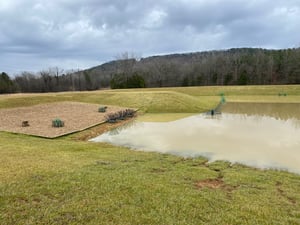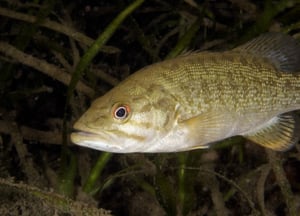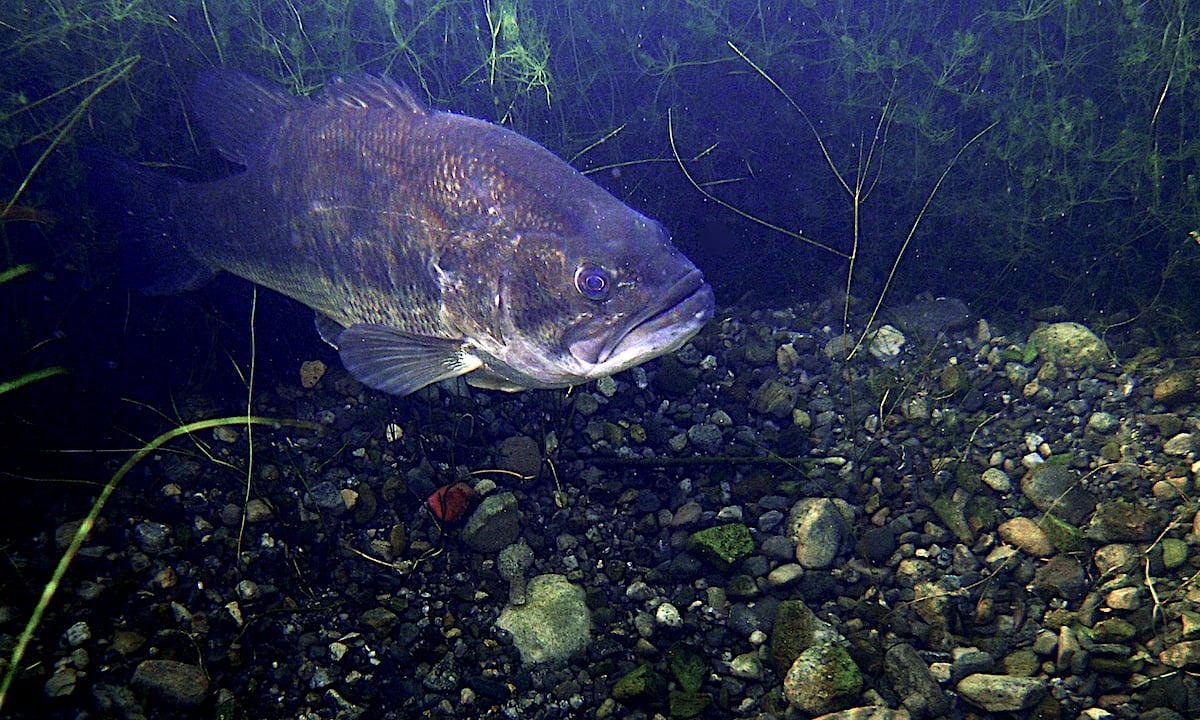Different species spawn at different times and require different types of habitat to spawn successfully. To minimize your supplemental stocking budget, it's helpful to understand these behaviors.
Why Does it Matter When Fish Spawn?

A common question the fisheries biologist of Pond King often get from private lake and pond owners is, “When do my fish spawn and where do they spawn?”
Well, we are going to cover this common question in depth for several stocked fish species commonly found in private ponds across Texas!
Why Does Understanding the Fish Spawn Help Your Private Lake?
By taking the time to understand when and where your fish spawn, you can manipulate your pond to ensure they have enough suitable habitat for a successful spawn year after year.
This will allow greater recruitment, thus ensuring the sustainability of your fish population. The pond owner can also ensure that there is sufficient “nursery” habitat like the Honey Hole fish nursery by Pond King in close proximity to these spawning habitats to increase survivorship of the fry and juvenile fish.
Are There Variables that Affect Spawning Fish?
For starters, not all the fish in your pond spawn at the same time of year. However, the majority of fish that you have in your pond will spawn either in spring or summer.
Some species of fish spawn only one time a year, while others spawn multiple times a year.
Not all spawning habitat is the same either! Different species require different habitats to spawn on/in.
Let's take a look at when and where some of your common species in your pond or local lakes spawn.
Understanding the Bass Spawn

The Largemouth Bass (Micropterus salmoides).
Largemouth bass spawn only once a year.
This occurs in spring when the water temperature reaches 55-70 degrees fahrenheit. The spawn is often induced by the full moon when the water temperature reaches the lower portion of this temperature range.
What Type of Habitat Do Largemouth Bass Spawn?
Largemouth bass seek out protected bays and shallow shoreline areas, often in the far back of creek arms near “nursery habitat.”
Nursery habitat can be vegetation, thick laydowns, buck brush, or any other shoreline habitat that gives their fry the best chances of surviving.
While largemouth bass will spawn on just about any substrate type, if present, they often opt for some sort of hard bottom.
This may be in areas of:
- gravel
- rock
- sand
- bedrock in a stream
Smallmouth bass (Micropterus dolomieu)

Smallmouth or “Smallies” are very similar to largemouth in that they spawn at around the same temperatures, 55-70 degrees fahrenheit.
However, smallmouth tend to stay much closer to the main lake and are not concerned with “nursery habitat” for their fry. They tend to seek shallower main lake flats and points with hard bottoms. Smallmouth bass are also more picky about the substrate they spawn on. They prefer pea gravel, fine rocks, or hard clay with sparse cover to nest on.
They also tend to nest deeper than largemouth so in our part of the world here in Texas we often will not see them on beds due to the turbidity of the water.
Can You Stock Smallmouth Bass in a Pond?
While smallmouth bass can do very well in a pond setting, we do not stock them in any of our customers' ponds because they are so finicky with the spawn.
If you have no recruitment in your pond, you will have to continuously stock more fish year after year to maintain a population.
As fisheries biologists, we aim to create a self-sustainable population/ecosystem in the water bodies Pond King manages.
Reasons Why Texas Ponds are Not Ideal for Smallmouth Bass
Another caveat as to why we prefer stocking largemouth bass over their smallmouth counterparts, is because most ponds already have largemouth in them. When stocking smallmouth in a small body of water currently occupied by largemouth bass, the largemouth bass will often out compete the smallmouth for forage and resources.
Lastly, the temperatures in Texas are very tough on the fish in ponds because of oxygen depletion. While smallmouth are a very adaptable fish, they are still a cool water fish and are subject to extra stress and decreased fitness when in an environment outside their comfortable temperature range.
The Bluegill Spawn

Like the Bass, Bluegill (Lepomis macrochirus) are a member of the sunfish family Centrarchidae.
Bluegill Spawning Temperatures and Season
Unlike the bass, bluegill spawn during the summer rather than the spring. Spawning often begins when the water temperatures reach 70 degrees fahrenheit and continue throughout the summer till water temperatures begin to cool.
This long spawning season is critical to the sustainability of bluegill, as in most ponds, as they are the primary forage for largemouth bass.
By spawning multiple times throughout the summer, their recruitment rate will hopefully become equal to or greater than the predation rate, resulting in a sustainable population.
What are the Types of Habitat for Spawning Bluegill?
Bluegill spawn in large groups, often a dozen or more, in a small area with round beds side by side. They look like a honeycomb pattern in the substrate of the pond.
Similar to that of largemouth, these beds are often in hard bottom substrate such as gravel or sand, but bluegill are adaptable and can use other types of cover and substrate for a successful spawn.
Crappie Spawn
Crappie, yet another member of the Centrarchidae family, spawn in the spring.
Like its other family members, crappie begin spawning when the water temperature reaches about 57 degrees and can continue till the water temperature reaches 75 degrees depending on the year.
Where Do Crappie Spawn?
Like both the bluegill and bass, both species of crappie, White Crappie (Pomoxis annularis) and Black Crappie (Pomoxis nigromaculatus) seek out shallow water to spawn.
Crappie can and will spawn in/on most shallow habitats, overhanging trees, water willow, cypress, or gravel to name a few.
Crappie Fry Behave Differently than Other Sunfish Species
One interesting habit of crappie is that the fry do not utilize the same nursery habitat as other sunfishes. Instead, after hatching the fry make their way out to deeper water.
This is something to keep in mind when managing your pond for crappie.
These fry are unprotected immediately after hatching, so the presence of young bass can really diminish the recruitment rates of your crappie. Management of crappie populations will involve the careful management of predation rates.
It is often wise to encourage some predation to prevent overpopulation as crappie have an extremely high fecundity. This birth rate can quickly unbalance your private lake's ecosystem if not properly managed.
Catfish Spawn
We often stock Channel Catfish (Ictalurus punctulatus) in ponds as a fun alternative fish to catch.
Why are Channel Catfish Good for Pond Stocking?
These catfish do extremely well in a pond and can be stocked in high densities on their own with bluegill or in conjunction with other game fish combinations without much worry of competition for resources between the species.
What are Prime Conditions for Spawning Channel Catfish?
Channel Catfish spawn in the summer, when water temperatures reach 70-85 degrees.
Channel, Blue Catfish (Ictalurus furcatus), and Flathead Catfish (Pylodictis olivaris) are all cavity nesters.
This means they nest in cavities such as hollow trees, underneath stump root wads, holes under and between rocks, or undercuts in the bank.
Because of these select nesting sites, catfish often do not spawn in a pond setting unless you have added these types of structures into your pond. Even then, chances are they are only large enough to hold a small portion of the population.
Be Prepared to Restock Your Private Pond after Harvesting Catfish
Recruitment rates will be very low and often not sustainable if individuals are being harvested, so supplemental stocking will likely be needed every few years.
Shiner Spawn
Golden Shiners (Notemigonus crysoleucas) are one of the most common baitfish stocked in Texas ponds.
They are also very common in use as fishing minnows.
Like our other forage fish (bluegill), golden shiners have a long spawning season that begins when water temperatures reach the 70 degree mark, and continue throughout the late spring to early summer, until the water temperatures surpass 80 degrees.
They have also been known to spawn a second time in the late summer early fall as water temperatures begin decreasing and fall back into the 70-80 degree range. While these shiners can lay their adhesive eggs to many substrate types, they often deposit them onto algae and other aquatic vegetation as they are omnivorous.
Eating a mixture of plant animal matter as well, gives the young fry some cover to increase their survival rate.
Golden Shiners have also been known to deposit their eggs on bluegill nests so that the male bluegill will unknowingly protect the eggs with its own till they hatch, increasing the survival rate.
Grass Makes a Great Habitat for Spawning Shiners
When wanting to ensure successful recruitment of Golden Shiners in your pond, it is suggested to leave some submergent grass as this is optimal spawning and nursery habitat for fry and juvenile shiners.
Fathead Minnow Spawn
Fathead Minnows (Pimephales promelas) are another very popular baitfish in Texas, often being stocking in new ponds with other juvenile fish, or as supplemental feeding for channel catfish.
Much like the golden shiners, the Fathead Minnows have a long spawning season to make up for short lifespans and increased predation rates.
Fatheads begin spawning when water temperature reaches 64 degrees in the spring and continue till it exceeds 80 degrees in the summer.
Fathead Minnows also have adhesive eggs that they lay and stick to the underside of different objects in the water.
This may include:
- underside of rocks
- dock floats
- aquatic vegetation
- wooden pallets
- laydowns
- any other structures placed into the water.
Maintaining sufficient horizontal habitat underwater will ensure sufficient spawning habitat in your pond for a sustainable fathead population and more available forage year after year for your smaller predators.
Tilapia Spawn
Tilapia (Oreochromis niloticus) are often stocked as a biological control for filamentous algae and/or as an alternative food source for your largemouth bass.
Tilapia are a unique fish with African origin, so they do very well in warm climates. While this fish does spawn very well in ponds, they will need to be restocked every year because they die off when the water gets below 52 degrees Fahrenheit.
However, tilapia reproduce extremely quickly. They spawn about every three to five weeks, sometimes more frequently under ideal conditions, starting in the spring when water temperatures exceed 72 degrees, and will continue until the water temperatures drop below 72 degrees in the fall.
The tilapia can spawn on a wide array of substrate types because Mozambique tilapia are mouth brooders.
What is a “Mouth Brooder” Fish?
This means that after the eggs have been fertilized, the female carries the eggs in her mouth until they hatch. The hatched fry remain in the mouth even up to a few days after they begin to feed on their own, using their mothers mouth as a refuge from predators.
Because of this, the survivorship of tilapia fry is extremely good, leading to fast acquisition of population numbers.
Speak to a Pond King Fisheries Biologist about Private Pond Management
I hope this blog helps you learn something about when and where some common species of fish spawn. Your pond or lake may require slight variations based on various conditions. If you have questions or have any observations of your own outside of what I outlined here, I’d love to hear from you. Contact us anytime or call to ask a pro how to better manage your lake!
See y'all down at the pond.




